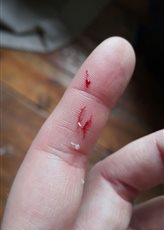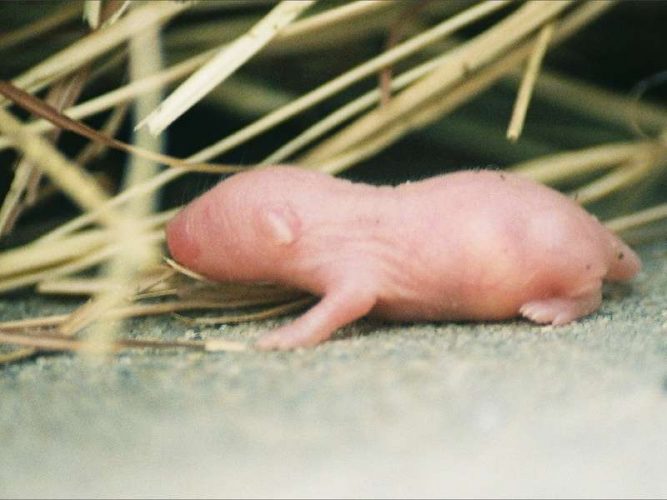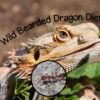Dr Callista Chinenye Emecheta is a Medical Practitioner and a Public Health enthusiast. Callista completed her Masters degree in Public Health in 2023 at the University of Northampton, UK.
Can my bearded dragon make me sick? Yes bearded dragons can present certain health risks to their owners. Pets often become integral parts of families, entwined with daily routines and interactions. Some pet owners allow bearded dragon’s close to their face or run around the house. Some bathe them in their kitchen sinks, let their toddlers touch them, or kiss their pets on the mouth.
However, this close contact between pet owners and their bearded dragons can make people sick through inadvertently leading to the transmission of various diseases. These illnesses may be bacterial, viral, or parasitic, and they can affect humans even if the bearded dragon appears healthy or if the contact is indirect, via other reptile handlers.
As pet owners we may not always be aware of the potential hazards that bearded dragons can pose. Despite the creatures being seemingly innocuous, there is a concrete risk of sickness, especially when they are allowed to roam freely in living spaces or are handled without adequate hygiene practices.
Bearded dragons have been identified to be carriers of bacteria, viruses, parasites and worms (Health protection surveillance Centre, 2013). It has been advised to treat them as contaminated even when they appear to be healthy.
The importance of maintaining a safe boundary and adhering to good husbandry and hygiene practices is vitally important to prevent the spread of zoonotic diseases, which are transmittable from animals to humans.
Table: Risks and Safety Measures for Bearded Dragon Owners
| Risk Factor | Safety Measure |
|---|---|
| Salmonella infection from kissing | Don’t kiss a bearded dragon |
| Tetanus from bites | Ensure up-to-date tetanus vaccinations |
| Secondary bacterial infection | Clean and disinfect bite wounds promptly |
| Zoonotic disease transmission | Practice good hygiene; seek medical advice if ill |

Jump To…
Key Takeaways
- Close contact with bearded dragons can pose health risks.
- Bearded dragons can carry bacteria and viruses without showing symptoms.
- Show affection to your bearded dragon safely to avoid health issues.
- Implement strict hygiene practices to prevent zoonotic diseases.
- Feeding mice to bearded dragons can indirectly affect human health.
- Know the steps to take if bitten by a bearded dragon to prevent infection.
- Young children and bearded dragons require careful supervision.
- Expectant mothers should exercise caution when handling bearded dragons.
- Recognize symptoms of infections from bearded dragons for early intervention.
- Regular vet check-ups for bearded dragons help prevent disease transmission.
Health Risks from Bearded Dragons
Can I Kiss my Bearded Dragon?
While expressing love for your pet is natural, but it’s important to be mindful of how you do so, for both your health and that of your bearded dragon. Avoid kissing your bearded dragon or allowing it close to your face.
Bearded dragons can carry harmful microorganisms like salmonella, which can spread to humans if ingested. Physical displays of affection like kissing your bearded dragon can result in the transmission of these microorganisms from your pet to you. These bacteria can be inadvertently ingested by humans, leading to serious health issues.
Will a Bearded Dragon Make me Sick if it Bites Me?
Yes, a bite from a bearded dragon can make you sick. Although their venom isn’t harmful to humans, bites can lead to other health issues such as tetanus or bacterial infections. It’s crucial to keep tetanus vaccinations up-to-date and to treat any bites promptly with thorough cleaning and antiseptics to prevent complications.
Immediate Actions after Being Bitten by a Bearded Dragon
If a bearded dragon bites you, taking immediate and appropriate action is key to minimizing health risks. Should the bearded dragon cling to you, it’s important to detach its jaws gently to avoid further injury. Cleaning and disinfecting the wound properly is essential, and seeking medical advice is always recommended to ensure comprehensive care.
- Release the Jaws: If the bearded dragon bites and holds on, carefully pry its jaws apart. Avoid jerking or dropping the dragon to prevent skin tears.
- Clean the Wound: Use soap and warm water to wash the bite thoroughly.
- Disinfect: Apply an antiseptic solution to the wound to prevent infection.
- Tetanus Immunization: Visit a healthcare provider to get a tetanus shot if your immunization is not current.
- Medical Evaluation: Seek medical attention if:
- The bite is deep or the skin is significantly torn.
- Signs of infection appear, such as increased pain, redness, tenderness, or pus discharge from the wound.
Is a Bearded Dragon Bite Dangerous to my Health?
While a bearded dragon bite itself may not be inherently dangerous, the risk of infection or contracting a zoonotic disease from the bite is a concern. Immediate and proper care following a bite can significantly reduce the risk of complications, making it less likely that a bearded dragon bite will make you sick. However, vigilance is necessary to ensure that what seems like a minor bite does not lead to more serious health issues.

Is it Safe to Have a Bearded Dragon Around Babies or Children?
When it comes to babies and young children, caution should be taken when they are with bearded dragons.
Research has consistently shown that bearded dragons, like other reptiles, can carry pathogens such as Salmonella spp, Campylobacter spp, and Aeromonas spp, which are capable of causing illness. Babies and young children, with their still-developing immune systems, are at a higher risk of falling ill. A common scenario where a bearded dragon might make someone sick is through the contamination of objects, such as baby bottles, with these bacteria.
Moreover, the risk isn’t limited to direct contact; indirect exposure to these harmful bacteria from a bearded dragon can also make someone sick. Young children, who frequently put their hands in their mouths, especially after touching pets, are at an elevated risk.
The Centers for Disease Control and Prevention (CDC) advises that to prevent the possibility that a bearded dragon might make someone sick, infants and children under five should avoid all contact with reptiles (Centers for Disease Control and Prevention, 2019a).
Echoing this sentiment, the National Health Protection Surveillance Centre has issued warnings to parents against keeping reptiles as pets in homes with infants and young children. This comes in the wake of an infant contracting botulism from a family pet turtle, underscoring the potential dangers (Health Protection Surveillance Center, 2011).

Are Bearded Dragons Safe When Pregnant?
Exercise caution with bearded dragons areound expectant mothers to mitigate any risk of contracting infections that could affect their health during pregnancy. Maintaining good hygiene and avoiding close facial contact with these pets can help reduce the chances of illness.
What can my Bearded Dragon Make Me Sick With?
Can I Make My Bearded Dragon Sick?
Reverse Zoonoses: Can Humans Make Bearded Dragons Sick?
Reverse zoonoses occur when diseases are transmitted from humans to animals. While common in some species like chimpanzees and pigs, documented cases in reptiles, especially bearded dragons, are scarce. Yet, the potential for humans to make bearded dragons sick exists due to shared bacteria that can cause illnesses in both humans and lizards.
Health Issues in Bearded Dragons Linked to Bacteria
To ensure the health and safety of your bearded dragon, consider the potential illnesses they may face and how these conditions can be prevented. Especially in the context of diseases that might be transmitted from humans to pets. Here’s a guide on the potential conditions and the preventive measures you can take:
| Condition | Causes | How Bearded Dragons Contract from Humans | Preventive Measures |
|---|---|---|---|
| Ulcerative Dermatitis (Scale Rot) | Bacterial and fungal infections. Aeromonas spp. and Pseudomonas spp. can worsen the condition. | Direct contact with contaminated surfaces or humans carrying these bacteria. | – Practice good personal hygiene, especially handwashing before and after handling your bearded dragon. -Regularly clean and disinfect the habitat. – Avoid handling your bearded dragon if you have open wounds. |
| Abscesses | Localized bacterial infections. | Bacteria transferred through cuts or open wounds. | – Keep the bearded dragon’s living area clean to reduce the risk of bacteria. – Monitor for any injuries on your pet and seek veterinary care promptly. – Use gloves if you have any cuts or wounds when handling your pet. |
| Infectious Stomatitis | Bacterial infection of the oral cavity, potentially spreading to the jaws. | Contaminated feeding equipment or direct contact with infected humans. | – Ensure all feeding equipment is sterilized and clean. – Avoid feeding your bearded dragon with your hands if you have cuts or sores. – Regular oral health checks by a veterinarian. |
Can my Bearded Dragon Catch my Cold?
Can my bearded dragon get sick if I have a cold? The risk of bearded dragons catching a cold from humans is low, as viruses causing the common cold in humans are not known to infect lizards (Marschang, 2011). However, maintaining good hygiene is essential to prevent any potential transmission of human illnesses to bearded dragons:
- Avoid sneezing or wiping nasal discharge on your bearded dragon.
- Always wash hands before and after handling your bearded dragon.
Doctor’s Tips on Good Hygiene Practices
The simplest of practices can go a long way in protecting you from a totally preventable illness. Here are some tips to help you stay safe and enjoy your bearded dragon.
Conclusion: Can my Bearded Dragon Make Me Sick?
While bearded dragons make fascinating and rewarding pets, it’s essential to recognize and mitigate the health risks they may pose to their owners. Understanding the potential for disease transmission, particularly through actions such as kissing bearded dragons, close facial contact, or improper handling of feeder mice for reptiles, is crucial for maintaining a safe and healthy environment for both you and your pet.
Will my bearded dragon make me sick if I implement proper hygiene? By implementing good hygiene practices, such as thorough handwashing and regular habitat cleaning, and by seeking prompt medical care for any bites or injuries, pet owners can significantly reduce the risk of infections. Remember, responsible pet ownership involves not only caring for the well-being of your bearded dragon but also protecting yourself and your family from potential health hazards.
FAQs
Can kissing my bearded dragon make me sick?
Yes, kissing or getting too close to your bearded dragon’s face can potentially make you sick. Bearded dragons can harbor harmful bacteria like Salmonella, which can be transmitted to humans through saliva and close contact.
What should I do if my bearded dragon bites me?
If your bearded dragon bites you, clean the wound thoroughly with soap and water, apply an antiseptic, and cover it with a sterile bandage. Seek medical attention to address further issues, or if you’re not up-to-date on tetanus shots.
Is it safe for my children to play with a bearded dragon?
Children can play with bearded dragons under adult supervision, but they should be taught to wash their hands thoroughly after handling the pet or its enclosure. Young children, in particular, should avoid close facial contact with the reptile.
References and further reading
- Birgitta, J., Andersson, Y., and Ekdahl, K. (2005). Effect of Regulation and Education on Reptile-associated Salmonellosis. Emerg Infect Dis. 11(3), 398 – 403. https://www.ncbi.nlm.nih.gov/pmc/articles/PMC3298264/
- Centers for Disease Control and Prevention. (2014). Human Salmonella Infections Linked to Pet Bearded Dragons. Centers for Disease Control and Prevention. https://www.cdc.gov/salmonella/cotham-04-14/index.html
- Centers for Disease Control and Prevention. (2019a). Healthy Pets, Healthy People. Centers for Disease Control and Prevention. https://www.cdc.gov/healthypets/specific-groups/children.html
- Centers for Disease Control and Prevention. (2020, September 18). CDC – Enterobiasis (also known as Pinworm Infection). ww.cdc.gov.
- Centers for Disease Control and Prevention. (2019, April 19). CDC – Enterobiasis (also known as Pinworm Infection) – Epidemiology & Risk Factors. ww.cdc.gov.
- Centers for Disease Control and Prevention. (2019b). Salmonella. Centers for Disease Control and Prevention. https://www.cdc.gov/salmonella/index.html
- Divers, S. J. (2019). Bacterial Diseases of Reptiles. MSD MANUAL Veterinary Manual. https://www.msdvetmanual.com/exotic-and-laboratory-animals/reptiles/bacterial-diseases-of-reptiles
- Ebbani, V., and Fratini F. (2005). Bacterial zoonozes among domestic reptiles. Ann Fac Med Vet, 58, 85-91. http://eprints.adm.unipi.it/185/1/84.pdf
- Edison, L., Knust, B., Petersen, B., Gabel, J., Manning, C., Drenzek, C., Stroher, U., Rollin, E. P., Thoroughman, D., and Nichol, S. T. (2104). Trace-Forward Investigation of Mice in Response to Lymphocytic Choriomeningitis Virus Outbreak. Emerging Infectious Diseases, 20(2), 291 – 295. https://doi.org/10.3201/eid2010.130861.
- European Food Safety Authority. (2018). The European Union summary report on trends and sources of zoonoses, zoonotic agents and food‐borne outbreaks in 2017. EFSA Journal, https://doi.org/10.2903/j.efsa.2018.5500
- Kirk, M., Ford, L., Glass, K., and Hall, G. (2014). Foodborne illness, Australia, circa 2000 and circa 2010. Emerg. Infect. Dis., 20, 1857–1864. https://doi.org/10.3201/eid2011.131315
- Health Protection surveillance Center. (2011). HPSC Warns of the Dangers of Reptiles to Children. https://www.hpsc.ie/a-z/zoonotic/reptilesandrisksofinfectiousdiseases/pressreleases/title-12387-en.html
- Health Protection Surveillance Center. (2013). Reptiles and the risk of Infectious Diseases. https://www.hpsc.ie/a-z/zoonotic/reptilesandrisksofinfectiousdiseases/
- Hydeskov, H. B., Guardabassi, L., Aalbæk, B., Olsen, K. E. P., Nielsen, S. S. and Bertelsen, M. F. (2013), Salmonella Prevalence Among Reptiles in a Zoo Education Setting. Zoonoses and Public Health, 60: 291–295. https://doi.org/10.1111/j.1863-2378.2012.01521.x
- Marschang, R. E. (2011). Viruses Infecting Reptiles. Viruses, 3,2087 – 2126. https://www.ncbi.nlm.nih.gov/pmc/articles/PMC3230843/pdf/viruses-03-02087.pdf
- Mills, R. (2014). How not to train your dragon, NHS gives warning to reptile owners kissing their pets. EPRESS. https://www.express.co.uk/scotland/461733/How-not-to-train-your-dragon-NHS-gives-warning-to-reptile-owners-kissing-their-pets/amp
- Parasite Vet.(n.d.). Pinworms in Reptiles. www.parasitevet.co.uk. Retrieved February 10, 2024
- Patrick, M. E., Gilbert, M. .J., Blaser, M. J., Tauxe, R. V., Wagenaar, J. A., and Fitzgerald C. (2013). Human infections with new subspecies of Campylobacter fetus. Emerging Infectious Diseases. 19: 1679-1680.
- Wang, C., and Shyu, C. (2013). Occurrence and molecular characterization of reptilian Campylobacter fetus strains isolated in Taiwan. Veterinary Microbiology, 164(1-2), 67-76. https://doi.org/10.1016/j.vetmic.2013.01.008
- Whiley, H., McLean, R., and Ross, K. (2017). Detection of Campylobacter jejuni in Lizard Faeces from Central Australia Using Quantitative PCR. Pathogens, 6(1): 1-5. https://doi.org/10.3390/pathogens6010001
- Whiley, H., van-den-Akker, B., Giglio, S., and Bentham, R. (2013). The Role of Environmental Reservoirs in Human Campylobacteriosis. Int J Environ Res Public Health. 10(11): 5886-5907. https://www.ncbi.nlm.nih.gov/pmc/articles/PMC3863877/






